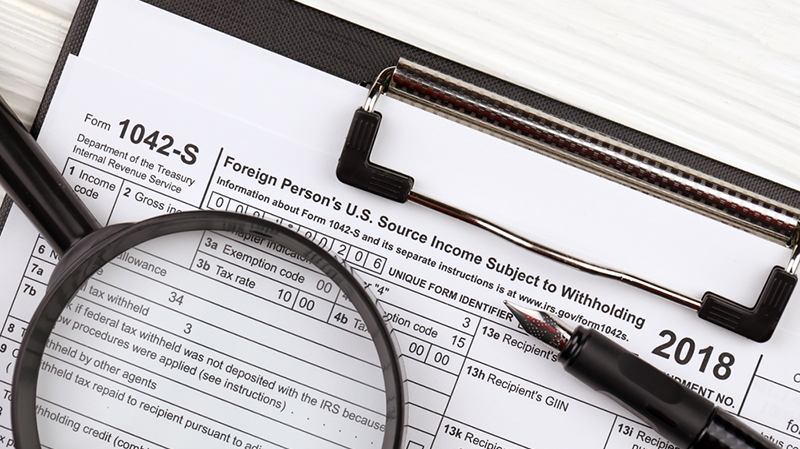US Tax Preparation for Americans Investing Abroad & US Businesses Operating Overseas
Navigating US tax preparation for Americans who invest internationally, have overseas investments, and US businesses operating internationally can be...
When conducting business across borders or managing foreign investments in the United States, it’s crucial to understand the tax implications of U.S.-sourced income paid to foreign persons. One of the most important IRS documents related to this subject is Form 1042-S, Foreign Person's U.S. Source Income Subject to Withholding. This form plays a central role in international tax compliance, and understanding how to file and use it correctly can help businesses, investors, and nonresident individuals avoid costly errors and ensure compliance with U.S. tax laws.
Form 1042-S is used to report income subject to withholding that is paid to foreign persons (nonresident aliens, foreign partnerships, corporations, estates, or trusts). This income typically includes:
Interest
Dividends
Royalties
Rents
Scholarship or fellowship grants
Compensation for personal services
Certain retirement income or pensions
The form is filed by U.S. withholding agents (such as financial institutions, employers, or other payers) who make these types of payments. It details the amount of income paid, the tax withheld, and the type of income. The information reported on Form 1042-S is used by the recipient to complete their U.S. tax return (usually Form 1040-NR) and by the IRS to match withholding and income records.
Any U.S. withholding agent—which can be a person or an entity—that makes payments of U.S.-source income to foreign persons must file Form 1042-S. This includes:
U.S. financial institutions or banks
Educational institutions paying scholarships or grants to foreign students
U.S. employers are paying foreign employees
Investment funds or real estate companies making distributions to foreign investors
Partnerships with foreign partners
U.S. trusts or estates distributing income to foreign beneficiaries
Foreign persons receiving the income do not file Form 1042-S themselves, but they will receive a copy from the withholding agent, which they will use for their own reporting purposes.
The due dates and filing processes for Form 1042-S are as follows:
To Recipients:
Form 1042-S must be furnished to the income recipient (the foreign person) by March 15 of the year following the calendar year in which the income was paid.
To the IRS:
Paper filing: Due by March 15 (accompanied by Form 1042-T).
Electronic filing: Also due by March 15. Mandatory if 250 or more forms are filed.
Electronic filing is done through the FIRE (Filing Information Returns Electronically) system. Withholding agents must also file Form 1042, the annual tax return that summarizes the total tax withheld and supports all 1042-S forms filed.
Filing Form 1042-S incorrectly can result in significant penalties and complications for both the withholding agent and the recipient. Common mistakes include:
Incorrect recipient information: Ensure the name, address, and taxpayer identification number (TIN) are accurate and consistent with the recipient's tax documentation (such as Form W-8BEN).
Wrong income code or exemption code: Use the correct income code to identify the type of income being paid, and the correct exemption code if reduced withholding applies under a tax treaty.
Mismatching amounts: Make sure that the amounts reported on Form 1042-S match those on Form 1042 and any payments made.
Late filing: Missing the deadline can trigger automatic penalties, so track all due dates carefully.
Failure to apply tax treaty benefits correctly: If a foreign person is claiming a reduced rate of withholding under a tax treaty, ensure that the proper documentation (e.g., W-8BEN or W-8ECI) is in place and that the treaty article is correctly cited.
Businesses and investors that deal with foreign entities or individuals need to be especially diligent with Form 1042-S reporting. Some key points to consider include:
Many foreign persons are eligible for reduced withholding under a tax treaty between their country and the United States. Withholding agents must verify eligibility and apply the correct rate. Failure to do so can result in over-withholding (bad for the recipient) or under-withholding (bad for the agent, as they may be liable for the shortfall).
Foreign investors in U.S. real estate may be subject to withholding under the Foreign Investment in Real Property Tax Act (FIRPTA). Form 1042-S is used to report these payments and withholdings.
Interest income paid to foreign investors may be exempt under the portfolio interest exemption, provided that certain conditions are met. Even if no tax is withheld, the income still must be reported on Form 1042-S.
If a U.S. partnership has foreign partners and is earning effectively connected income (ECI), the partnership must withhold on distributions and report the foreign partner’s share on Form 1042-S.
Failure to file Form 1042-S accurately and on time can lead to:
Filing penalties: Up $310 per form (as of 2025), depending on how late the form is filed.
Withholding agent liability: If insufficient tax is withheld, the agent may be held personally liable for the shortfall, plus interest and penalties.
Loss of tax treaty benefits: Improper filing or missing documentation can result in the denial of reduced rates under applicable tax treaties.
To stay compliant and avoid penalties, withholding agents should maintain up-to-date W-8 forms and verify their validity regularly, use a robust withholding tax engine or software to automate calculations and classifications, and schedule internal compliance reviews and mock audits to catch potential issues.
Consult with a qualified international tax advisor or CPA to ensure correct interpretation of treaty benefits and withholding requirements.
At H&CO, we specialize in helping U.S. businesses, foreign investors, and international entities manage their cross-border tax obligations. From proper withholding calculations to timely filing of Forms 1042, 1042-S, and 1042-T, we ensure you remain compliant while optimizing your tax position.
Yes. Even if no tax was withheld due to a treaty exemption or the income is not taxable, you must still report the payment on Form 1042-S.
Yes. Foreign individuals typically use Form 1042-S to complete Form 1040-NR, the U.S. income tax return for nonresident aliens.
A TIN is generally required to claim treaty benefits. If the foreign person doesn’t provide a TIN, withholding may have to be done at the full statutory rate (30%).
Form 1099 is used for U.S. persons, while Form 1042-S is used exclusively to report U.S.-source income paid to foreign persons.

Navigating US tax preparation for Americans who invest internationally, have overseas investments, and US businesses operating internationally can be...

The United States-Turkey Income Tax Treaty is a cornerstone for fostering economic collaboration and providing clarity in cross-border taxation....

In today's interconnected global economy, businesses and individuals face a multitude of challenges and opportunities when it comes to managing their...
